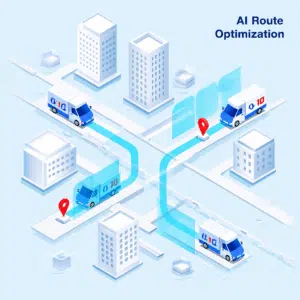With all of the buzz around the word “Machine Learning” in the world of business today, it has become increasingly difficult to determine what it actually means and how it can help businesses. The contemporary commercial sector has taken an interest in the potential of machine learning, its advantages, and how it might be implemented in various types of business enterprises.
At its core, machine learning can be best described as a process through which machines can learn to recognize patterns that help automate everyday tasks. It is a subset of Artificial Intelligence and should not be confused with simple automation, as it actively learns from each dataset fed into the ML system.
Understanding Machine Learning Integration: Key Concepts and Benefits
The first step in the process is understanding what machine learning is and what it implies. Other than the definition that we discussed earlier, machine learning helps us find and extract useful information from vast raw data sets. The trends, statistics, and patterns that underlie the data that most companies gather on a daily basis are where machine learning is considered most useful. This could be anything from consumption patterns to regular purchase activity for a technology-based store to shipment data in maritime transport.
The reason why experts at RTS Labs think that machine learning is a game changer in data analytics is that the algorithms and analytical models employed in machine learning can adapt to the changing nature of the data we collect. The more data a machine learning system is fed with, the more insightful and precise its results will be.
Machine learning helps companies to boost productivity and increase profitability by discovering valuable insights buried in your databases. Especially after the Covid-19 breakout, businesses relying on machine learning have been better able to adapt and respond to drastically shifting market conditions. In order to pair machine learning with Artificial Intelligence as a potent analytical tool, such as Azure Machine Learning and Amazon SageMaker, you can utilize cloud technologies to integrate machine learning into any type of business imaginable.
Benefits of Using Machine Learning Integration
Higher ROIs
Automation and machine learning enhance the overall efficiency of business processes within a company, leading to a greater return on investment (ROI). For example, machine learning-based predictive marketing strategies perform better than retired and outdated techniques that marketers have used for decades. Moreover, implementing data-driven buying suggestions is shown to maximize revenue while minimizing turnover.
Reducing Operating Expenses
The integration of machine learning tools and techniques into a variety of corporate operations can result in large company-wide cost savings. One way to go about it is to eliminate the expenses that are often associated with human labor. For example, salaried expenses become less of a problem when highly-trained chatbots replace customer service representatives. The same is true for automating other repetitive and monotonous tasks, such as bookkeeping, data entry, and retail transactions.
Another place where ML helps cut down costs is how it automates recruiting processes. Machine learning reduces the amount of time and human resources required for the entire hiring and recruitment process, from start to finish. It also eliminates the time and work wasted in a failed recruitment effort.
Improved Accuracy
This one is fairly straightforward. When people find themselves doing extremely repetitive jobs manually, there is a high probability that they will end up making costly errors. Machine learning-based techniques, on the other hand, are fully error-free and dependable.
Improved Productivity
Manual data entry procedures require a significant amount of time and effort from humans. By automating such operations, workers are freed to pursue other valuable and productive endeavors. It also expedites the process in question and improves productivity. Individuals in data-intensive areas like accounting or data entry may also utilize the technology to get deeper insights and improve value for all stakeholders.
Best Practices for Successful Machine Learning Integration
Step 1: Define the Issue
The first step involved in the implementation of any machine learning project is to develop an understanding of the business requirements. So many businesses commit the error of employing machine learning merely owing to its popularity in the tech-entrepreneurship area.
Simply put, you need to know what problem you’re trying to solve before attempting to solve it. In order for this vastly complex technology to have a tangible impact and address current problems in your business, it is essentially critical to identify the specific business processes that need to be improved. At all costs, avoid getting lost in the buzz around ML and establish well-defined target areas for practical application.
Step 2: Define the Opportunity’s Scope
After you have pinpointed the issue/process, the next stage is to develop a solution structure. This is where you will have to determine your goals, who the stakeholders are, and the current state of the process you are trying to change. Only when you have all of this information at your disposal, can you choose the best route to take when implementing the solution to certain processes through machine learning.
Strive for clarity on how you will implement the output of your model and the potential consequences on consumers and staff from the start. Otherwise, without appropriate integration of this algorithm, you’ll just have a bunch of numbers that provide no useful insight into your business.
Step 3: Create Relevant Data
The data ecosystem that is going to support your corporate integration is one of the most crucial phases in installing a machine-learning solution for your company. A company cannot completely capitalize on an opportunity unless it gathers and usefully categorizes essential data. This is the critical foundation that eliminates the possibility of a lose-lose situation, where data outputs are as useless as the inputs.
Step 4: Bring in the Right People
We cannot stress this enough: effective machine learning integration relies on you building the right team of people to carry it out. This is a complex task for HR, since it is about putting together a cross-functional team that includes, but is not limited to, a data engineer, domain expert, and statistician. Admittedly, much of this can be outsourced, but it is equally crucial to have an internal pipeline that makes sure effective adoption of ML systems.
Real-World Examples of Machine Learning Integration in Action
Understanding User Profiles
The primary use case for ML is understanding the type of customer that a business attracts, and this is most commonly seen in the retail industry. For example, a clothing store may have access to vast amounts of information relating to client purchases, but only when this data set is run through a machine learning algorithm is when it can be truly useful for forecasting customer buying behaviors, trend analysis, best-selling items, and other useful pointers that enable timely business decisions. These ad profiles are best utilized by Facebook, which employs sophisticated technologies such as automatic face tagging and complex user datasets to provide meaningful ads to one’s home feed.
Inventory Management
Order placement can be highly simplified based on the intersections of what the market needs and what the customers want. In order to make logistics and operations as streamlined as possible, connecting machine learning algorithms to marketing tools can help directly promote items to particular customers. ML can look at the surfing behavior of users, accurately infer what they prefer buying, and then recommend to them exactly what they need until an order is placed.
By recognizing underlying patterns in quality control failures, machine learning can prove to be extremely effective at reducing manufacturing faults to ensure improved product quality and reliability. This also contributes significantly to the scalability of your business venture because the same issues will not repeat twice. Amazon Logistics utilizes advanced machine learning algorithms to ensure the timely delivery of all Amazon products with the least amount of human error possible.
Security Enhancements
In a world that is overly reliant on web services, cyber security is more important than ever before. While we are more connected and can meet most of our needs at our fingertips, machine learning is especially effective against some malicious threats. These include phishing, identity theft, ransomware, NDA confidentiality issues, privacy breaches, and so on.
This additional layer of protection can also facilitate existing cybersecurity teams by taking charge of tedious monitoring tasks and vulnerability assessment reports. An algorithm is far less likely to fail a routine checkup compared to a human who is prone to error. One great example is the spam filter, where employee inboxes no longer need to be flooded with dangerous emails because the ML data sets have become more rigorous and efficient at stopping them in their tracks. Since ML algorithms continue to evolve with time and become better at what they do, the more spam emails that the system goes through, the better it gets at recognizing and eventually removing these threats altogether. Gmail utilizes a more advanced variant of the same spam filter that we discussed earlier to ensure only current and useful emails take space in your inbox.
Financial Management
In the field of financial analytics, ML algorithms are incredibly useful for estimating future corporate spending and conducting a cost-benefit analysis for every new venture that a firm may decide to pursue. Algorithmic trading and fraud detection are some of the more complex tasks that ML can help with since they are heavily reliant on trend analysis. All of these use cases depend on examining already existing data to better predict the future. The accuracy will vary based on the quality of the data and the machine learning model or algorithm that you use.
The results here may also vary based on the complexity of the task, because a modest data set and a simple algorithm can very easily handle simple tasks. It is the inconsistent and variable nature of some tasks – such as day-trading of stocks – where algorithms will have to rely on human tweaks, years of data collection, and regular revisions in order to have even a usable model that investors and stockbrokers can comfortably rely on.
However, the cost savings here cannot be understated because the end result is still precise and timely projections that help firms manage expenditures, predict movements, and enhance overall profitability with ease. PayPal extensively uses machine learning-based security measures to ensure secure international transactions and prevent fraud.
Cognition Services
Machine learning is capable of helping with cognition-based services like image identification and natural language processing. This is especially true for recent improvements in image recognition technology, which for example, will allow companies to build more secure and easy authentication alternatives to product identification that support autonomous retail services such as cashier-less checkout. It has led to breakthrough shopping experiences such as Amazon Go that need minimal human intervention.
Businesses can offer their services to a wide range of clients from vastly different social, cultural, and ethnic origins using the power of natural language processing. This is possible due to the incredibly sophisticated machine learning models, such as ChatGPT.
Additionally, delivering services and experiences in a client’s native language doesn’t just grow your user-base, but makes all content on the internet more accessible in the long run. Google Translate utilizes natural language processing, alongside other localized technologies such as POS tagging, NER, and chunking, to understand and translate words in the right tone.
Challenges and Limitations of Machine Learning Integration
The biggest hurdle when implementing machine learning in business processes is a lack of decent data. While most AI developers are concerned with improving algorithms that already exist, those same algorithms can prove to be useless when the right data quality does not exist. The archenemies of ideal machine learning integration are noisy data (meaningless data), dirty data (faulty data), and incomplete data.
Machine learning typically requires vast amounts of data processing power that most companies do not have. Legacy systems frequently fail to handle this kind of workload and come-under. It’s important to determine if your current infrastructure can handle machine learning. If it cannot, you should consider upgrading through hardware acceleration, cloud solutions, and increased storage.
Most companies already have analytics engines in place by the time they decide to upgrade to machine learning. Newer machine learning processes are harder to implement on top of existing methodologies. This is where maintaining proper company-wide interpretation and documentation comes in handy.

Future Outlook: The Role of Machine Learning Integration in Digital Transformation
One cannot understate just how vast the impact of machine learning can have on many emerging and established industries. From pointing out insights that hide in plain sight and predicting outcomes with surprising accuracy, machine learning is the future of business technologies. For example, in the future, retail store customization algorithms will likely become extremely fine-tuned, resulting in significantly more customized experiences for all users.
On the other hand, unsupervised machine learning algorithms will grow common too, requiring little to no human intervention to identify their outputs. If Quantum-powered systems were to become a reality, their algorithmic processing will radically accelerate how fast machine learning operates.
In time, one can even expect highly intelligent applications that can communicate with their surroundings by speaking, hearing, seeing, and even reasoning with them.
What are your thoughts on how machine learning is helping our future? What can machine learning really do for business? Let us know in the comments. At RTS Labs, we make software that gives you an unfair advantage. Our elite cross-functional teams bring you the agility of a startup and the scalability of an industry leader.






